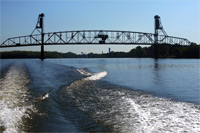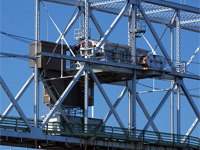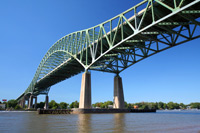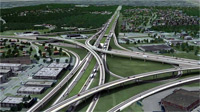|
|
|
12 September 08: Burlington & Bristol: expecting twins

Turn off your mind, relax and float downstream. The Summer of the Delaware is not dying . . . it is not dying. We still have nine bridges to go on our
way to the
sea, and the next two on our river sojourn are just around the bend (in the River), just past US Steel, a little downstream from the "scenic overlook", a short barge ride from Pennsbury Manor.
Bristol, Pennsylvania and Burlington, New Jersey go back. Way back. Bristol was originally settled in 1681 and fast became a desirable location. (It
incorporated
in 1720.) While William Penn had his modest home in Philadelphia (which he barely lived in), he chose for his estate a spot on the Delaware just above
Bristol.
There was already ferry service when he arrived, from Bristol to Burlington, where Quakers had established a coat factory congregation the decade
prior to
Penn's arrival to the colonies. The ferry service between the towns, which was long the most direct route across the Delaware between Philadelphia and
New York,
continued all the way into the 1930s, when a more permanent bridge, which didn't concede to the weather, was built.
 The Burlington-Bristol Bridge opened in 1931. As with most major roads and bridges in the Delaware Valley, Steve Anderson's PhillyRoads.com has a great historical background on its coming to
be.
The Burlington-Bristol Bridge opened in 1931. As with most major roads and bridges in the Delaware Valley, Steve Anderson's PhillyRoads.com has a great historical background on its coming to
be.
Of all the tidal Delaware bridges, the Burlington-Bristol may be the least visible of them. All of the other bridges south of Trenton either carry or
have a
connection with major thoroughfares like I-95 or the PA and NJ Turnpikes. Burlington-Bristol connects PA-413 with NJ-413, which at less than a mile is
merely an
extension of PA-413 to US-130 in Jersey.
While Burlington-Bristol certainly has seniority over its more robust neighbor to the north, the Delaware River-Turnpike Toll Bridge (which we'll get
to in a
moment), it is by no means forgotten or unused. The two lanes of metal grating still carry thousands of cars each day between the south end of Bristol
borough and
Burlington city, where there is now a landscaped promenade on the river where there were once factories and warehouses. The riverboat Liberty Belle docks at this park.
The most important, and unique, function of the Burlington-Bristol lends to its utilitarian aesthetic -- the lift span. The clearance at the center of
the bridge
at high tide is only 61 feet, so taller vessels must request that the center span be raised so that they may pass through. From the Burlington County Bridge Commission:
When the lift span is raised mechanically to permit passage of the vessel, concrete counterweights are lowered at each end of the span to
maintain a
balanced condition.
 That includes during rush hour; the bridge operator is at the beck and call of the captain, no matter what time of day. Therefore, the built-in bridge
house
(pictured at right), one of the signature features of the bridge, is manned 24/7.
That includes during rush hour; the bridge operator is at the beck and call of the captain, no matter what time of day. Therefore, the built-in bridge
house
(pictured at right), one of the signature features of the bridge, is manned 24/7.
For a new mini-essay of photos of the Burlington-Bristol Bridge (17 total), please click
HERE.
* * *
About three miles upstream, on the other side of Burlington Island -- the island in the Delaware River with a lake of its own -- is a larger bridge
with a larger
ambition.
The Delaware River-Turnpike Toll Bridge, the strangely hyphenated, verbosely named steel arch structure also connects Burlington and Bristol --
Burlington Township
and Bristol Township. It opened in 1956, a promontory summit bringing the Pennsylvania Turnpike to the New Jersey Turnpike, each of which was extended
after World
War II -- PA from Valley Forge, NJ from Exit 6. Again, an excellent back story by Steve Anderson is at PhillyRoads.com.
 It's a shame an effort by a PA branch of AAA to name it "William Penn Bridge" failed, because the handsome structure deserves a better name than
Delaware
River-Turnpike Toll Bridge. For our purposes, let's call it the Turnpike Bridge, since it connects the two historic turnpikes.
It's a shame an effort by a PA branch of AAA to name it "William Penn Bridge" failed, because the handsome structure deserves a better name than
Delaware
River-Turnpike Toll Bridge. For our purposes, let's call it the Turnpike Bridge, since it connects the two historic turnpikes.
The Turnpike Bridge opened on May 25, 1956, one month and four days before President Dwight Eisenhower signed his landmark Federal Aid Highway Act. It
truly
carried an Interstate Highway one month before Interstate Highways existed. Of course both the PA and NJ Turnpikes predate perhaps the most important
interstate of
our time, I-95 -- known in PA as the Delaware Expressway for the river it parallels and the communities that depend on it.
Right now, famously, 95 is a mess between Philly and Jersey, the only interruption in the nearly 2,000 mile highway between Miami and Canada, and all
megalopolitan
points between. Travel north on 95 in PA, end up heading south on 295. Travel north on the New Jersey Turnpike, which turns into 95, and bypass the
original 95 in
PA. Also famously, there is no direct connection between the PA Turnpike (I-276) and I-95. But there soon will be, solving both problems.
There was actually supposed to be a PA Turnpike-95 connection from the start. I-95 was planned to go directly through Trenton via the
Trenton-Morrisville Bridge,
but New Jersey
legislators protested on the thought that the US-1 corridor could not support such traffic. The road was instead routed just west, crossing the
Delaware at Scudder
Falls Bridge, and the alignment of 95 did not match with the existing PA Turnpike exit structure. People who've been asking ever since why they didn't
just build a
new interchange will have that question satisfied beginning early next year.
 The Pennsylvania Turnpike begins in 2009 the $650M fixing of what has for too long been broken. (Click that graphic for more maps on the project's official web site.) While I certainly don't advocate for the construction of new highways,
this
interchange has long been needed, addressing both the PA Turnpike/95 problem, but more importantly, providing the last solid link to at last complete
I-95.
The Pennsylvania Turnpike begins in 2009 the $650M fixing of what has for too long been broken. (Click that graphic for more maps on the project's official web site.) While I certainly don't advocate for the construction of new highways,
this
interchange has long been needed, addressing both the PA Turnpike/95 problem, but more importantly, providing the last solid link to at last complete
I-95.
When the interchange is completed, I-95 will follow the Pennsylvania Turnpike east across the Turnpike Bridge to the New Jersey Turnpike, where it
will
continue again northward, providing the continuous eastern seaboard highway that was envisioned over a half a century before. Philadelphians who
choose to shirk
the obvious non-driving options -- Amtrak, Septa/NJT, Chinatown bus, Bolt Bus -- will at last have an uninterrupted route between Philly and New York,
with no
navigating of traditional Jersey roads like 38 and 70 just to find the Turnpike. (Can't make any promises after Exit 14 -- count on a backup at the
Holland.)
No sooner than the north-south through traffic starts backing up on the four lane Turnpike Bridge (two lanes each way), construction will begin on its
twin.
Estimated to begin in 2012 and be open in 2015, the Turnpike Bridge -- which I suppose by then will be called the I-95 Bridge, or the 95 Delaware
River
Bridge -- will have an identical, steel arch twin next to it, one for northbound traffic and one for
southbound. It'll be kinda like the other twin bridges across the Delaware -- the ones that are the final destination of the tidal bridge series.
For a new mini-essay of photos of the Delaware River-Turnpike Toll Bridge (18 total), please click
HERE.
–B Love
|
SUMMER OF THE DELAWARE ARCHIVES:
|
|